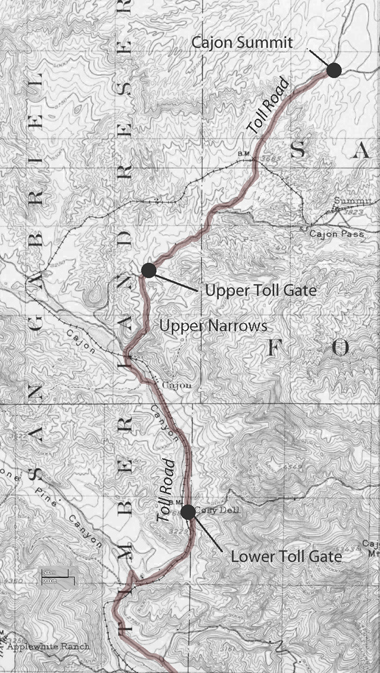Toll Road through the Cajon Pass
Leases Road to McKenney and Mathews
In April of 1868 Brown ran an advertisement announcing he had leased the road out to others for a period of one year so that he could take a vacation:-
The undersigned...would respectfully inform his friends and the public that he has leased his Toll Road in the Cajon Pass, to the enterprising gentlemen, McKenney & Mathews, for the term of one year, they taking possession on the 25th Inst., and are to keep the road in good repair....
This road is twelve miles in length, crossing the entire range of the Sierra Nevada, and like all other mountain Roads is subject to damage by floods. The proprietor has spared no pains in keeping the Road in repair at all Seasons of the year. No Road in the State is kept in better condition....
Flooding problems revisited the pass in March 1869, when torrents of rain from a cloudburst did extensive damage to Brown's toll road. The road was impassable for heavily loaded wagons, and a large work crew was needed to restore it.
The road crossed Cajon Creek about one-half mile above the lower narrows on what was then the site of the Faurot house (later called Bear Flat Ranch or Station, and now known as Cosy Dell). During the storm, three men attempted to cross the creek at this spot, but the flooding was so bad they lost their wagon and everything in it, their four horses drowned, and the men only narrowly escaped with their own lives.
The destruction once again of his road must have made Brown feel the job he had taken on was next to impossible. But some of the travelers on the turnpike were unsympathetic to the problems he faced in maintaining it, and as the traffic on the road grew over the years, so did the protests about the condition in which it was kept.
Historical accounts show that the trip over the toll road was difficult, to say the least. In 1865 Elliot Coues had traveled through Cajon Pass on a journey in which he retraced the route taken by Francisco Garces in 1775-76, and the data Coues gathered on the trip was later published in his book, On the Trail of a Spanish Pioneer. He described Brown's turnpike as a "narrow, deep and tortuous canyon, the roughest I have ever traversed on wheels; there was ten miles of this from the tollgate to Martin's ranch."
Others were just as dissatisfied as Coues. In 1873, after receiving increasing complaints and a petition from teamsters objecting to the sorry state of the road, the Board of Supervisors agreed there was a need to address the problem, although no action was taken at that time.
< Previous - Next >

-=-